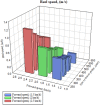Development and evaluation of a battery powered harvester for sustainable leafy vegetable cultivation
- PMID: 41028026
- PMCID: PMC12484774
- DOI: 10.1038/s41598-025-03594-4
Development and evaluation of a battery powered harvester for sustainable leafy vegetable cultivation
Abstract
Crop harvesting, a crucial part of cultivation, has traditionally depended on manually, and despite technological advancements benefiting most crops through mechanical harvesting, the manual method of harvesting of shorter crops (one foot in height) continues to persist. Recognizing this challenge, an innovative solution has emerged a self-propelled battery-operated leafy-vegetable harvester specifically designed for leafy vegetables, integrating battery technology to mechanize the harvesting. Design Expert statistical software was used to identify optimal solutions for the laboratory analysis harvester using the Response Analysis and Multi-Parameter Simulation (RAMPS) model. The analysis revealed that the highest cutting efficiency was achieved at a cutter bar speed of 370.67 strokes/min with a forward speed of 2 km/h. Further optimization showed that a reel speed of 0.32 m per second at a forward speed of 1.65 km/h, with a driven pulley size of 558 mm (level 6 of B), resulted in highest harvesting efficiency. Additionally, the optimal conveyor performance was observed at a speed of 0.86 m/s, with a forward speed of 1.857 km/h and a driving pulley size of 101.6 mm (level 3 of A). The harvester was tested across speeds ranging from 1.5 to 5 km/h, with power requirements between 157 and 542 watts. Within this range, the battery-powered harvester provided an operating time of 2.25 to 7.8 h and the total energy required as 107.36 MJ/ha. By integrating battery technology, the harvester influences to sustainable agricultural practices, supporting with global efforts to minimize carbon emissions. This innovative attempt provides a viable solution for smallholder farmers, developing agricultural productivity and supporting the transition to more sustainable farming methods.
Keywords: Battery; Harvesting; Leafy vegetables; Self-propelled; Sustainable agricultural.
© 2025. The Author(s).
Conflict of interest statement
Declarations. Competing interests: The authors declare no competing interests.
Figures












References
-
- Yang, L. N. et al. Enhanced agricultural sustainability through within-species diversification. Nat. Sustain.2, 46–52. 10.1038/s41893-018-0201-2 (2019).
-
- Patel, S. K., Sharma, A. & Singh, G. S. Traditional agricultural practices in India: An approach for environmental sustainability and food security. Energy Ecol. Environ.5, 253–271. 10.1007/s40974-020-00158-2 (2020).
-
- Umeda, S. et al. Cost and workload assessment of agricultural drone sprayer: A case study of rice production in Japan. Sustainability14, 10850. 10.3390/su141710850 (2022).
-
- Sinébou, V. C. O. et al. Toward the Reshaping of an endogenous Leafy Vegetable value chain: The Case Study of Vitex doniana in the Republic of Benin. Econ. Bot.77, 455–475. 10.1007/s12231-023-09591-w (2023).
-
- Zahari, N. E., Sazali, N., Harun, Z. & Sazali, N. The analysis of risk factor repetitive motion in manufacturing activities based on ergonomics. In Proceedings of the 2nd Energy Security and Chemical Engineering Congress. Lecture Notes in Mechanical Engineering (eds Johari, N. H., Wan Hamzah, W. A., Ghazali, M. F., Setiabudi, H. D. & Kumarasamy, S.) (Springer, 2023) 10.1007/978-981-19-4425-3_12.
MeSH terms
LinkOut - more resources
Full Text Sources

